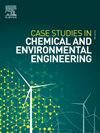Investigating the essential oil production from agricultural food waste: A case study Chaiyaphum province, Thailand
Q1 Environmental Science
Case Studies in Chemical and Environmental Engineering
Pub Date : 2025-09-19
DOI:10.1016/j.cscee.2025.101286
引用次数: 0
Abstract
The valorization of agricultural food waste into high value bioproducts aligns with the principles of sustainable development and circular bioeconomy. This study investigates the extraction, chemical characterization, and techno-economic feasibility of essential oil production from three selected agricultural residues: lemongrass leaves, bergamot peels, and peppermint. Utilizing steam distillation under controlled conditions (90 minutes at 100 °C, 5:1 water-to-biomass ratio), the maximum essential oil yields were 0.55 % (w/w) for both lemongrass and bergamot, and 0.48 % (w/w) for peppermint. Fourier Transform Infrared Spectroscopy was employed to identify the dominant functional groups in the oils, revealing key constituents such as aldehydes, alcohols, alkanes, and carbonyl compounds, which support their bioactivity and aromatic potential. A comparative cost analysis demonstrated that lemongrass and bergamot offer the most favorable cost-to-yield ratio, with production costs ranging from $3.00 to $6.00 per 5 kg batch, corresponding to approximately $0.11–$0.22 per milliliter of oil. Although peppermint oil exhibited a slightly lower yield and higher raw material cost, its elevated market value particularly in pharmaceutical and oral care industries may compensate for the reduced process efficiency. When benchmarked against solvent extraction and supercritical CO2 techniques, steam distillation emerged as the most accessible and economically viable method for community-scale operations, offering a safer and more sustainable alternative. This study highlights the feasibility of integrating decentralized essential oil production systems into agro-waste management frameworks, particularly within rural and community enterprise contexts. The findings support the broader implementation of low-cost, resource-efficient extraction technologies for converting biomass waste into marketable natural products, thereby enhancing rural incomes and reducing environmental burdens.
调查从农业食品废弃物中生产精油:以泰国猜雅府为例
将农业食品垃圾转化为高价值生物产品符合可持续发展和循环生物经济的原则。本研究考察了从柠檬草叶、佛手柑皮和薄荷三种选定的农业残留物中提取精油、化学特性和技术经济可行性。在控制条件下(100°C, 90分钟,水与生物质比为5:1),柠檬草和佛手柑的最大精油收率为0.55% (w/w),薄荷的最大精油收率为0.48% (w/w)。傅里叶变换红外光谱法鉴定了油中的主要官能团,揭示了关键成分,如醛、醇、烷烃和羰基化合物,这些成分支持其生物活性和芳香潜力。一项比较成本分析表明,柠檬草和佛手柑具有最有利的成本产出比,每5公斤批次的生产成本在3美元到6美元之间,相当于每毫升油约0.11美元到0.22美元。虽然薄荷油的产量略低,原料成本较高,但其市场价值的提高,特别是在制药和口腔护理行业,可能弥补了工艺效率的降低。与溶剂萃取和超临界CO2技术相比,蒸汽蒸馏成为社区规模操作中最容易获得、最经济可行的方法,提供了一种更安全、更可持续的替代方案。这项研究强调了将分散的精油生产系统纳入农业废物管理框架的可行性,特别是在农村和社区企业背景下。研究结果支持更广泛地实施低成本、资源高效的提取技术,将生物质废物转化为可销售的天然产品,从而提高农村收入并减轻环境负担。
本文章由计算机程序翻译,如有差异,请以英文原文为准。
求助全文
约1分钟内获得全文
求助全文
来源期刊

Case Studies in Chemical and Environmental Engineering
Engineering-Engineering (miscellaneous)
CiteScore
9.20
自引率
0.00%
发文量
103
审稿时长
40 days
 求助内容:
求助内容: 应助结果提醒方式:
应助结果提醒方式:


